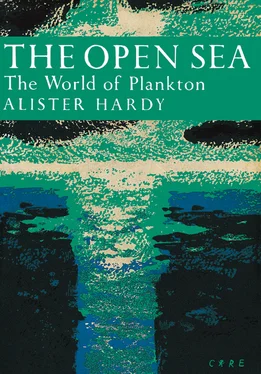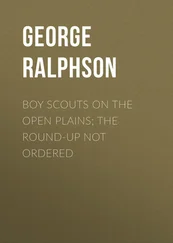Dinoflagellates, like other flagellates, multiply by simple fission into two and, like diatoms, each daughter-cell retains one half of the old cell-wall and forms another half anew; but unlike the diatoms the new halves are not formed within the old cell wall and so there is no gradual diminution in size. Occasionally recently-divided individuals of Ceratium may remain adhering together to form little chains. The cell-wall grows in thickness but when the little plates of armour become too heavy they fall off to be replaced by new and extremely thin ones. The long horns of Ceratium are certainly organs to assist in suspension. Species in the warmer waters generally have much longer ones than those in colder waters. Warmer water is more fluid—or less viscid—than colder water, for the molecules move over one another more freely with greater heat-motion; in the tropics an object will sink twice as fast as will one of similar density and shape in the polar seas. In general plankton organisms, both plants and animals, are more spiny in the tropics to give them a greater surface resistance. It has been observed that species of Ceratium have the power of adjusting the length of their horns to the varying viscosity of the water; on being carried by currents into warmer water they grow longer horns, conversely if carried into a colder area they can shed parts of them. (Gran 1912).
Several species of Dinoflagellates can produce a brilliant phosphorescence. Many plankton animals are luminous and produce the sparks of light we often see in the water at night. In addition to such displays, however, we may also see a more general ghostly light or sometimes when out in a rowing boat our oar as it cuts the water may leave a trail of blue-green flame behind it; and even from the shore we may see the waves breaking in a flash of light. Such displays are caused by countless millions of dinoflagellates each glowing by an oxidation process as it is agitated in the water. Noctiluca is the most celebrated for this, but although a dinoflagellate it is curiously modified to be entirely animal in its mode of life and so will be described in a later chapter ( see here); other members of the group, however, particularly Ceratium , give almost as good a display. Once on a fisheries research trawler, having stopped at night to make some observations in the Channel, I looked over the side to see a small shoal of fish, most likely mackerel, lit up by each individual being covered by a coat of fire; they were being chased this way and that by some much larger fish similarly aflame. On putting over a tow-net, which came up brilliantly illuminated, the sea was seen to be full of a very small Peridinium -like dinoflagellate of the genus Goniaulax.
Two other genera of dinoflagellates occuring in our waters, and shown in Fig. 15, will just be mentioned. Dinophysis has the part of the body in front of the girdle reduced to a minimum so that the girdle itself, with very pronounced margins to its groove, appears like a band round its very front or top; the posterior part bears a marked keel at one side as if designed to prevent the rotation which is normal to the group. Instead of spinning round it is thought to set up a vortex current by which it draws into the groove still smaller organisms as food. Polykrikos is a remarkable genus having a number of girdles, usually four or eight, placed in regular succession down the body; it is often spoken of as a ‘colonial form’ as if made up of several individuals which have failed to separate on division, but this can hardly be the correct view since the number of nuclei is always smaller than the number of girdles present. It appears to be an individual with a repetition of organs similar to the segments of an animal like an annelid worm. They are also said to feed like animals as well as like plants; they possess remarkable little capsules containing coiled threads which can be shot out like those found in the stinging cells of sea anemones and jelly-fish, and may possibly be used for a similar purpose—the capture of prey. In addition to all these forms with their different characteristic patterns of armour plating and spines, there are a great many so called ‘naked’ dinoflagellates which lack all such coverings; many of these are, for part of their lives, internal parasites in a number of different marine animals.
Among the small shells of Globigerina first brought up from the ooze of the ocean bed were found numbers of still smaller calcareous bodies, little plates, some oval and perforated, others round and bearing stout blunt spines; they were called coccoliths and rabdoliths respectively, and presented naturalists with a puzzle as to what they were. It was Sir John Murray who discovered their real nature by showing them to be plates which had covered the bodies of other little plank-tonic flagellates which were given the name of Coccolithophores. 1 Coccosphaera and Coccolithus ( Fig. 15) occur in our seas. They are commoner in the tropics, although in the Atlantic water coming into the northern North Sea they may occasionally be so numerous as to give a milky appearance to the water and cause a chalky deposit to be left on the fishing nets as they dry. This is what the herring fishermen call ‘white water’ and generally believe to be a good sign for the presence of herring. A well-known herring skipper, Mr. Ronald Balls, who is also a keen naturalist, has recently written, under the pen-name of “Peko”, an excellent article on this white water in World Fishing (July 1954). He describes how this water gives ‘the queer impression of whiteness coming upwards: as if the light was below the sea instead of above it’. He then refers to recent views that the coccoliths are shields reflecting light from their owners which normally live in tropical seas where the illumination is too strong; ‘and here’, he writes, ‘was the perfect explanation of the fairy glow or white reflection that I had experienced long ago, and wrote about before I knew even that this organism existed’. As with the cell walls of diatoms, the electron microscope is showing that each little plate or coccolith has a much more complicated structure than was originally supposed; its base consists of radiating ribs like the spokes of a wheel and its rim is decorated with a frill like that with which a chef may decorate a ham. There are other similar little creatures, the Silicoflagellates, which form a delicate siliceous skeleton with radiating spines ( Fig. 15, i and j ).
Herring nets, although they hang in the water near the surface, may often come out of it in a very slimy condition; this may be due to an excessive number of diatoms; more usually, however, it is due to globules of jelly large enough to be seen quite easily by the unaided eye. These slimy blobs are produced by aggregates of microscopic flagellates called Phaeocystis which colour the surface of the jelly in green patches ( Fig. 15k). All the meshes of a tow-net may be blocked with them. Dense concentrations of Phaeocystis , like those of diatoms, which cover wide areas of sea, have also been thought to have a deleterious effect on the shoaling of herring and at times to have led to a poor or delayed fishery. We shall refer to this again in Chapter 15.
This completes the review of those planktonic plants we shall mention by name; but we have so far left out of account a vast number of still much smaller flagellates which have escaped capture by passing through the meshes of the finest net we can use. It is only comparatively recently that their influence in the economy of the sea has been realised. Their prominence was first demonstrated by the German naturalist Lohmann who examined the remarkably fine filtering mechanism, far finer than any gauze that man can make, used for their capture by some little plankton animals, the Larvacea, to be described here. They may, however, be extracted from a sample of sea water by centrifuging 2 small quantities of it in tapering tubes. If after such treatment the greater part of the water is carefully decanted, a drop of the remaining fluid may be taken up in a pipette and examined on a slide under the high power of a microscope; then they will be seen as tiny yellow specks jigging in the water Today a great many of these minute flagellates are being successfully cultured in the laboratory, notably by Dr. Mary Parke at Plymouth (1949). Five examples, sketched in line from her beautiful coloured drawings, are shown in Fig. 15 n – r .
Читать дальше












